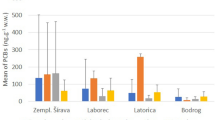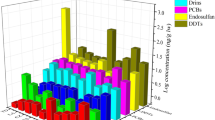Abstract
SINCE residues of polychlorinated biphenyls (PCBs) were identified in Swedish wildlife1, they have been reported in many marine species2–7. Samples of marine fish and molluscs from Scottish waters have been analysed for organochlorine residues at this laboratory on several occasions since 1965, and the concentrations of PCB residues detected in these samples have been generally highest from the Firth of Clyde. Therefore a wide variety of samples from this area was used in the autumn of 1969 to try to establish the route by which the PCB residues reached the fish. Samples of the water surface film and sub-surface water were taken at various points in the estuary, and also at 2-mile intervals along the river to the centre of Glasgow, to detect any local discharges containing PCBs, No PCB residues could be found (limit of detection in water, 1 part in 1011) and samples of effluents discharged from trunk sewers into the estuary and in the Glasgow area also showed no significant concentrations of PCBs. Concentrations in zooplankton by comparison were less than 0.03 p.p.m. (3 parts in 108), and in clupeoid fish up to 2.6 p.p.m. (both expressed on a wet weight basis).
This is a preview of subscription content, access via your institution
Access options
Subscribe to this journal
Receive 51 print issues and online access
$199.00 per year
only $3.90 per issue
Buy this article
- Purchase on Springer Link
- Instant access to full article PDF
Prices may be subject to local taxes which are calculated during checkout
Similar content being viewed by others
References
Jensen, S., New Scientist, 32, 612 (1966).
Holden, A. V., and Marsden, K., Nature, 216, 1274 (1967).
Risebrough, R. W., Rieche, P., Peakall, D. B., Herman, S. G., and Kirven, M. N., Nature, 220, 1098 (1968).
Koeman, J. H., Ten Noever de Brauw, M. C., and de Vos, R. H., Nature, 221, 1126 (1969).
Holden, A. V., ICES C. M. 1969 Fisheries Improvement Committee, Document No. E: 22 (mimeo) (1969).
Jensen, S., Johnels, A. G., Olsson, M., and Otterlind, G., Nature, 224, 247 (1969).
Nature, 224, 402 (1969).
Holden, A. V., and Marsden, K., J. Chromatog., 44, 481 (1969).
Reynolds, L. M., Bull. Env. Contam. and Toxicol., 4, 128 (1969).
Author information
Authors and Affiliations
Rights and permissions
About this article
Cite this article
HOLDEN, A. Source of Polychlorinated Biphenyl Contamination in the Marine Environment. Nature 228, 1220–1221 (1970). https://doi.org/10.1038/2281220a0
Received:
Issue Date:
DOI: https://doi.org/10.1038/2281220a0
This article is cited by
-
Polychlorinated biphenyls in the sediments of the inner Oslofjord
Water, Air, and Soil Pollution (1982)
-
Persistence of formulated fenitrothion in distilled, estuarine, and lake water microcosms in dynamic and static systems
Bulletin of Environmental Contamination and Toxicology (1982)
-
Organics at the air-water interface of Lake Pontchartrain
Bulletin of Environmental Contamination and Toxicology (1979)
-
Translocation of the polychlorinated biphenyl Aroclor 1254 from soil into carrots under field conditions
Archives of Environmental Contamination and Toxicology (1976)
-
Distribution of polychlorinated biphenyls in an aerated biological oxidation wastewater treatment system
Bulletin of Environmental Contamination and Toxicology (1974)
Comments
By submitting a comment you agree to abide by our Terms and Community Guidelines. If you find something abusive or that does not comply with our terms or guidelines please flag it as inappropriate.



